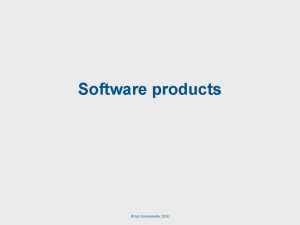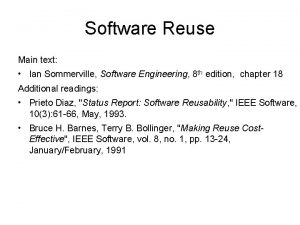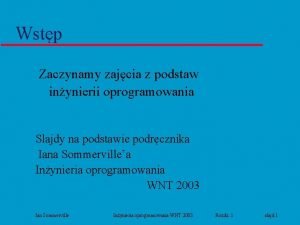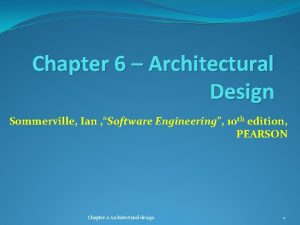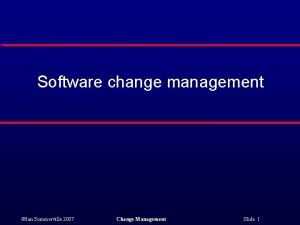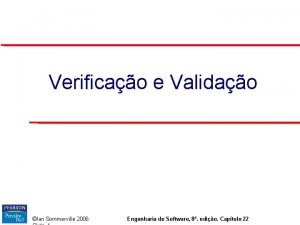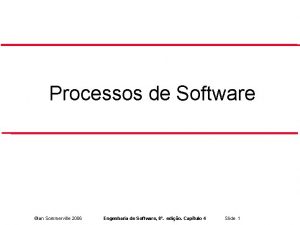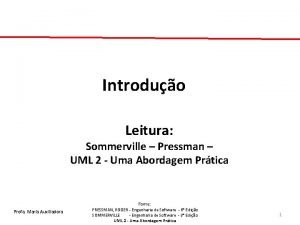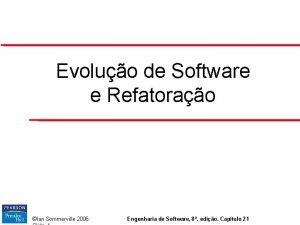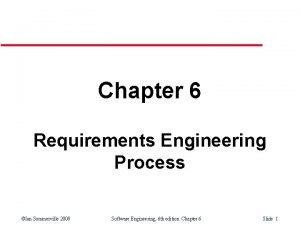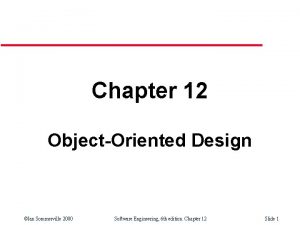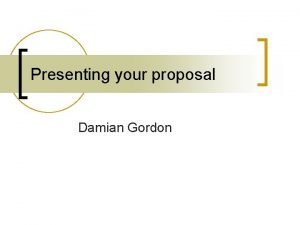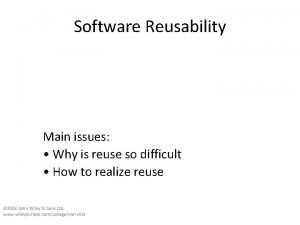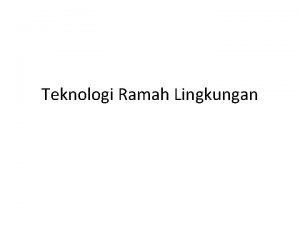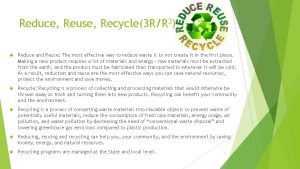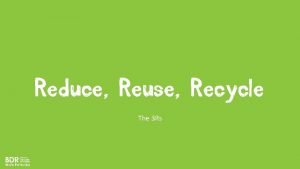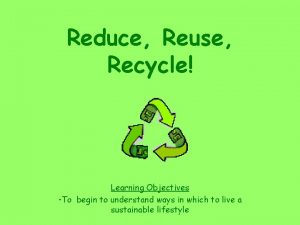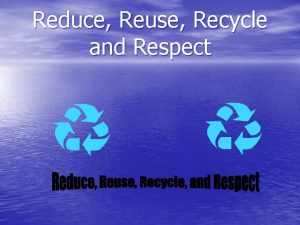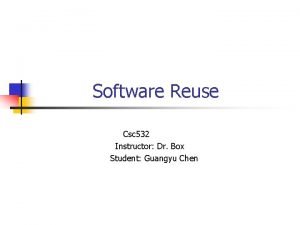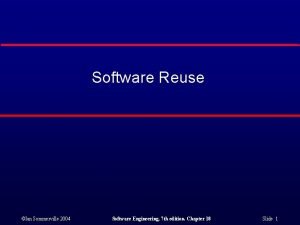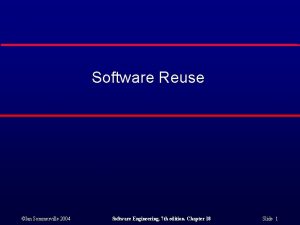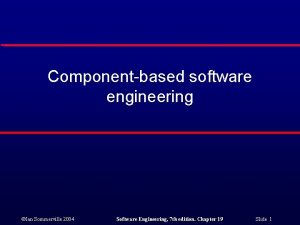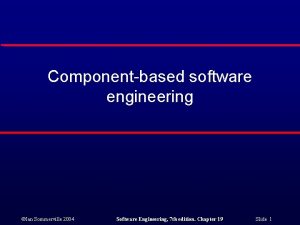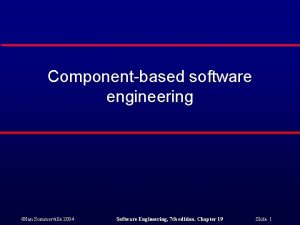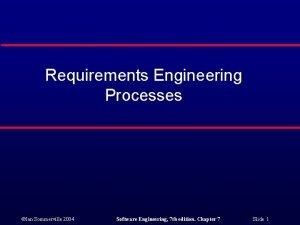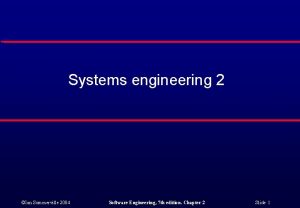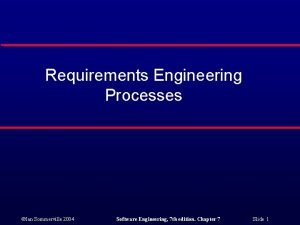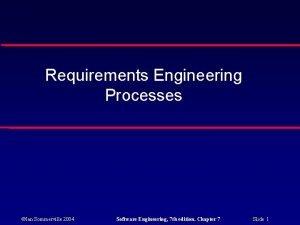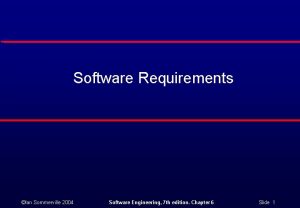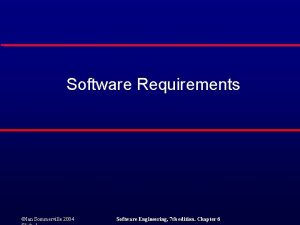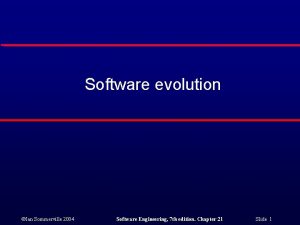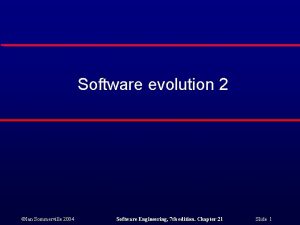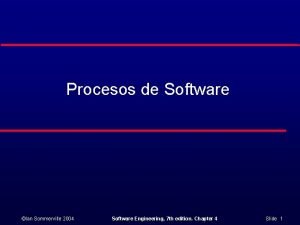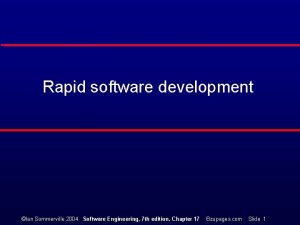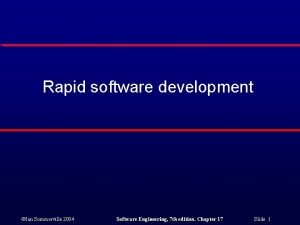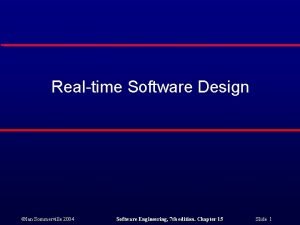Software Reuse Ian Sommerville 2004 Software Engineering 7























- Slides: 23

Software Reuse ©Ian Sommerville 2004 Software Engineering, 7 th edition. Chapter 18 Slide 1

Objectives l l l To explain the benefits of software reuse and some reuse problems To discuss several different ways to implement software reuse To explain how reusable concepts can be represented as patterns or embedded in program generators To discuss COTS reuse To describe the development of software product lines ©Ian Sommerville 2004 Software Engineering, 7 th edition. Chapter 18 Slide 2

Software reuse l l In most engineering disciplines, systems are designed by composing existing components that have been used in other systems. Software engineering has been more focused on original development but it is now recognised that to achieve better software, more quickly and at lower cost, we need to adopt a design process that is based on systematic software reuse. ©Ian Sommerville 2004 Software Engineering, 7 th edition. Chapter 18 Slide 3

Reuse-based software engineering l Application system reuse • l Component reuse • l The whole of an application system may be reused either by incorporating it without change into other systems (COTS reuse) or by developing application families. Components of an application from sub-systems to single objects may be reused. Covered in Chapter 19. Object and function reuse • Software components that implement a single welldefined object or function may be reused. ©Ian Sommerville 2004 Software Engineering, 7 th edition. Chapter 18 Slide 4

Reuse benefits 1 ©Ian Sommerville 2004 Software Engineering, 7 th edition. Chapter 18 Slide 5

Reuse benefits 2 ©Ian Sommerville 2004 Software Engineering, 7 th edition. Chapter 18 Slide 6

Reuse problems 1 ©Ian Sommerville 2004 Software Engineering, 7 th edition. Chapter 18 Slide 7

Reuse problems 2 ©Ian Sommerville 2004 Software Engineering, 7 th edition. Chapter 18 Slide 8

The reuse landscape l l l Although reuse is often simply thought of as the reuse of system components, there are many different approaches to reuse that may be used. Reuse is possible at a range of levels from simple functions to complete application systems. The reuse landscape covers the range of possible reuse techniques. ©Ian Sommerville 2004 Software Engineering, 7 th edition. Chapter 18 Slide 9

The reuse landscape ©Ian Sommerville 2004 Software Engineering, 7 th edition. Chapter 18 Slide 10

Reuse approaches 1 ©Ian Sommerville 2004 Software Engineering, 7 th edition. Chapter 18 Slide 11

Reuse approaches 2 ©Ian Sommerville 2004 Software Engineering, 7 th edition. Chapter 18 Slide 12

Reuse planning factors l l l The development schedule for the software. The expected software lifetime. The background, skills and experience of the development team. The criticality of the software and its nonfunctional requirements. The application domain. The execution platform for the software. ©Ian Sommerville 2004 Software Engineering, 7 th edition. Chapter 18 Slide 13

Concept reuse l l When you reuse program or design components, you have to follow the design decisions made by the original developer of the component. This may limit the opportunities for reuse. However, a more abstract form of reuse is concept reuse when a particular approach is described in an implementation independent way and an implementation is then developed. The two main approaches to concept reuse are: • • Design patterns; Generative programming. ©Ian Sommerville 2004 Software Engineering, 7 th edition. Chapter 18 Slide 14

Design patterns l l A design pattern is a way of reusing abstract knowledge about a problem and its solution. A pattern is a description of the problem and the essence of its solution. It should be sufficiently abstract to be reused in different settings. Patterns often rely on object characteristics such as inheritance and polymorphism. ©Ian Sommerville 2004 Software Engineering, 7 th edition. Chapter 18 Slide 15

Pattern elements l Name • l l Problem description. Solution description. • l A meaningful pattern identifier. Not a concrete design but a template for a design solution that can be instantiated in different ways. Consequences • The results and trade-offs of applying the pattern. ©Ian Sommerville 2004 Software Engineering, 7 th edition. Chapter 18 Slide 16

Multiple displays ©Ian Sommerville 2004 Software Engineering, 7 th edition. Chapter 18 Slide 17

The Observer pattern l Name • l Description • l Used when multiple displays of state are needed. Solution description • l Separates the display of object state from the object itself. Problem description • l Observer. See slide with UML description. Consequences • Optimisations to enhance display performance are impractical. ©Ian Sommerville 2004 Software Engineering, 7 th edition. Chapter 18 Slide 18

The Observer pattern ©Ian Sommerville 2004 Software Engineering, 7 th edition. Chapter 18 Slide 19

Generator-based reuse l l Program generators involve the reuse of standard patterns and algorithms. These are embedded in the generator and parameterised by user commands. A program is then automatically generated. Generator-based reuse is possible when domain abstractions and their mapping to executable code can be identified. A domain specific language is used to compose and control these abstractions. ©Ian Sommerville 2004 Software Engineering, 7 th edition. Chapter 18 Slide 20

Types of program generator l Types of program generator • • • l l Application generators for business data processing; Parser and lexical analyser generators for language processing; Code generators in CASE tools. Generator-based reuse is very cost-effective but its applicability is limited to a relatively small number of application domains. It is easier for end-users to develop programs using generators compared to other component-based approaches to reuse. ©Ian Sommerville 2004 Software Engineering, 7 th edition. Chapter 18 Slide 21

Reuse through program generation ©Ian Sommerville 2004 Software Engineering, 7 th edition. Chapter 18 Slide 22

Key points l l l Advantages of reuse are lower costs, faster software development and lower risks. Design patterns are high-level abstractions that document successful design solutions. Program generators are also concerned with software reuse - the reusable concepts are embedded in a generator system. ©Ian Sommerville 2004 Software Engineering, 7 th edition. Chapter 18 Slide 23
 Engineering software products ian sommerville
Engineering software products ian sommerville Simple aspect example
Simple aspect example Inżynieria oprogramowania ian sommerville
Inżynieria oprogramowania ian sommerville Sommerville software engineering slides
Sommerville software engineering slides Sommerville 2007
Sommerville 2007 Sommerville
Sommerville Sommerville
Sommerville Sommerville
Sommerville Uml 2 uma abordagem prática
Uml 2 uma abordagem prática Sommerville
Sommerville Sommerville
Sommerville Sommerville
Sommerville Elaine sommerville
Elaine sommerville 666 rule powerpoint
666 rule powerpoint Software reuse
Software reuse Computer based system engineering in software engineering
Computer based system engineering in software engineering Forward engineering in software engineering
Forward engineering in software engineering Contoh refine teknologi ramah lingkungan
Contoh refine teknologi ramah lingkungan 3r reduce reuse recycle
3r reduce reuse recycle Reduce reuse recycle adalah
Reduce reuse recycle adalah Reduce reuse recycle objectives
Reduce reuse recycle objectives Reduce recycle reuse and respect
Reduce recycle reuse and respect Frekuensi reuse
Frekuensi reuse Advantages of reuse
Advantages of reuse
